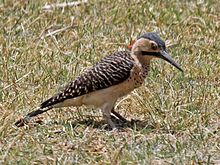
The red-crowned woodpecker is a species of bird in the subfamily Picinae of the woodpecker family Picidae. It is found in Costa Rica, Panama, Colombia, Venezuela, Guyana, Suriname, and Tobago.

The golden-olive woodpecker is a species of bird in the subfamily Picinae of the woodpecker family Picidae. It is found from Mexico south and east through Panama, in every mainland South American country except Chile, Paraguay, and Uruguay, and Trinidad and Tobago.

The streaked tuftedcheek is a passerine bird in the Furnariinae subfamily of the ovenbird family Furnariidae. It is found in Bolivia, Colombia, Ecuador, Peru, and Venezuela.

The plain-mantled tit-spinetail is a small passerine bird of South America in the Furnariinae subfamily of the ovenbird family Furnariidae. It is found in Argentina, Bolivia, Chile, and Peru.

The crimson-bellied woodpecker is a species of bird in subfamily Picinae of the woodpecker family Picidae. It is found in Bolivia, Colombia, Ecuador, and Peru.
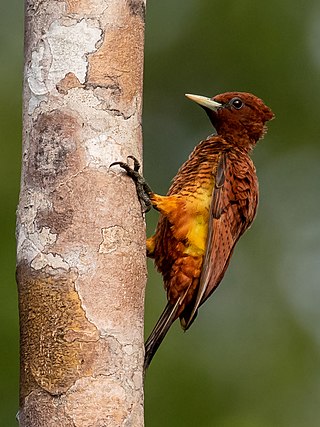
The scaly-breasted woodpecker, also known as the scale-breasted woodpecker, is a subspecies of bird in subfamily Picinae of the woodpecker family Picidae. Some taxonomists consider it a separate species. It is found in Bolivia, Brazil, Colombia, Ecuador, Peru, and Venezuela.

The pale-crested woodpecker a species of bird in subfamily Picinae of the woodpecker family Picidae. It is found in Argentina, Bolivia, Brazil, and Paraguay.

The rufous-headed woodpecker is a species of bird in subfamily Picinae of the woodpecker family Picidae. It is found in Bolivia, Brazil, Ecuador, and Peru.

The ringed woodpecker is a species of bird in subfamily Picinae of the woodpecker family Picidae. It is found in every mainland South American country except Argentina, Chile, Paraguay, and Uruguay.

The waved woodpecker is a species of bird in subfamily Picinae of the woodpecker family Picidae. It is found in Bolivia, Brazil, Colombia, Ecuador, French Guiana, Guyana, Peru, Suriname, and Venezuela.

The black-necked woodpecker or black-necked flicker is a species of bird in subfamily Picinae of the woodpecker family Picidae. It is endemic to Peru.

The campo flicker is a species of bird in subfamily Picinae of the woodpecker family Picidae. It is found in Argentina, Bolivia, Brazil, Paraguay, Suriname, and Uruguay.

The green-barred woodpecker or green-barred flicker is a species of bird in subfamily Picinae of the woodpecker family Picidae. It is found in Argentina, Bolivia, Brazil, Paraguay and Uruguay.
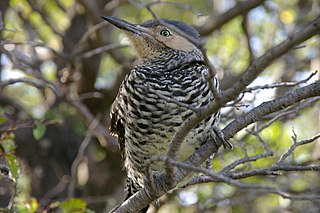
The Chilean flicker is a species of bird in subfamily Picinae of the woodpecker family Picidae. It is found in Argentina and Chile.

The grey-crowned woodpecker is a species of bird in subfamily Picinae of the woodpecker family Picidae. It is endemic to western Mexico.

The golden-green woodpecker is a species of bird in subfamily Picinae of the woodpecker family Picidae. It is found in Panama and every mainland South American country except Chile and Uruguay.
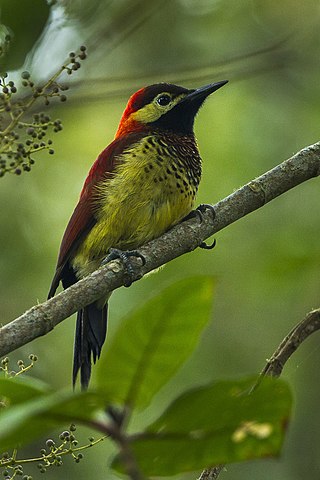
The crimson-mantled woodpecker is a species of bird in subfamily Picinae of the woodpecker family Picidae. It is found in Bolivia, Colombia, Ecuador, Peru, and Venezuela.
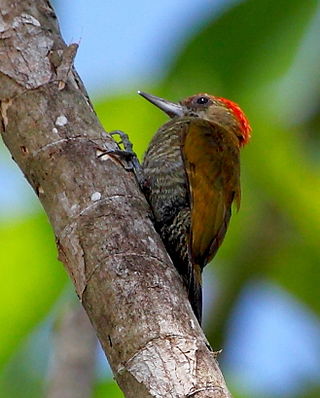
The red-stained woodpecker is a species of bird in subfamily Picinae of the woodpecker family Picidae. It is found in Bolivia, Brazil, Colombia, Ecuador, Peru, and Venezuela.

The bronze-winged woodpecker is a species of bird in subfamily Picinae of the woodpecker family Picidae. It is endemic to northeastern Mexico.

The splendid woodpecker is a species of bird in subfamily Picinae of the woodpecker family Picidae. It was formerly considered conspecific with the crimson-bellied woodpecker and some taxonomists retain that treatment. It is found in Colombia, Ecuador, and Panama.



